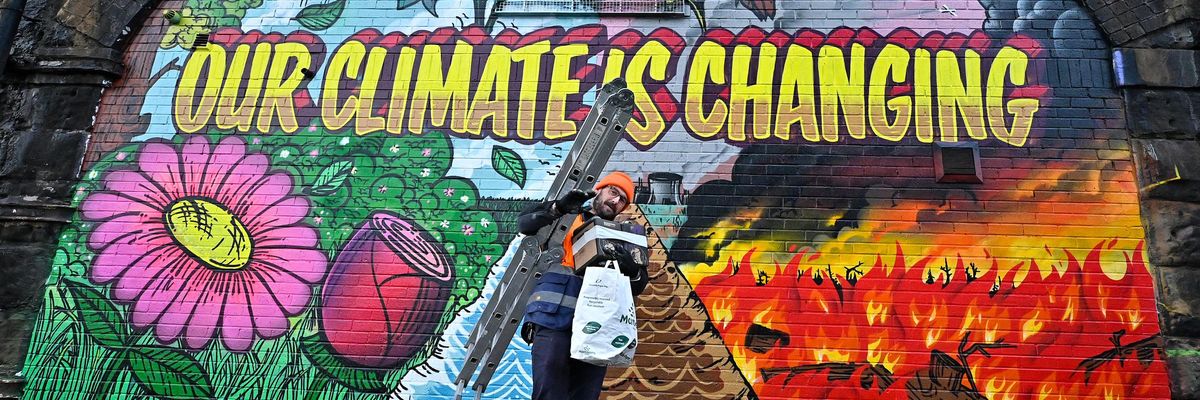The protocol was agreed just half an hour before another conference was due to move into the building, and only after a secret telephone summit between Blair, Clinton and the Japanese prime minister, Ryutaro Hashimoto, with the German chancellor, Helmut Kohl, also involved.
It was unambitious: only the 37 Western industrialized countries were obliged to reduce emissions, and then by only 5.2% by 2008-2012. Agreement on how to implement it was put off for three years, until COP6 in the Hague.
That event, as it turned out, was held in November 2000, at the same time as George W. Bush and Gore were contesting the results of the US presidential election. Bill Clinton, finally appreciating what was at stake, told his delegates to deal. Prescott (again with Meacher) got major concessions out of the US and its allies, only to have them rejected by radical green European environment ministers. He went back and got more, but again the Europeans resisted, causing him to walk out flamboyantly.
"It's OK," one Scandinavian minister reassured me, eyeing Prescott's retreating back. "There's going to be a new president. We'll get more from him." Oh yeah? Within months, Bush had rejected the Kyoto Protocol altogether.
The next eight years were a hard slog against American opposition. It even took until 2005 to bring the protocol into force. But then came a breakthrough, and it owed much to plastic ducks.
In December 2005, at Montreal's COP11, the US was, as ever, refusing to consider tightening the protocol's targets. When a final compromise was suggested, US negotiators walked out, insisting: "If it looks like a duck, it's still a duck."
Immediately, the most effective US climate campaigner--Philip Clapp, then head of the National Environmental Trust--went out and bought every plastic duck he could find, and started distributing them. Soon they were everywhere, peeping out of delegates' breast pockets, cascading out of ministers' opened briefcases, even bobbing about in lavatories. Reduced to a laughing stock, the US gave way. An agreement was made to start negotiating new emissions cuts: many delegates shed happy tears.
Less joyful tears flowed down the cheeks of Yvo de Boer, the UNFCCC's normally phlegmatic executive secretary, two years later, when faced with renewed American intransigence at COP13 in Bali.
Unprecedentedly, the US was booed and hissed by delegates of the other 190 nations. In a game-changing speech, Papua New Guinea's delegate, Kevin Conrad, told US delegates: "If you are not going to lead, get out of the way." Embarrassed again, the US backed down. The conference agreed to a "roadmap", putting the world on track for the Copenhagen climate summit (COP15) in December 2009.
How 'Hopenhagen' turned horrid
In half a century of covering UN conferences, I have never known such an important one open with as much optimism as "Hopenhagen", as it was dubbed. True, preliminary negotiations had gone slower than expected and there was no prospect of concluding a formal treaty. However, in the preceding weeks, all the main emitters of carbon dioxide had announced unprecedented measures to control their pollution and differences had so narrowed that an effective political agreement seemed within reach. More than 120 leaders rushed to attend, confident of its lustre rubbing off on them.
They were met with a shambles, poorly run by the Danish prime minister, Lars Lokke Rasmussen. The talks began to fall apart as soon as the second day. A compromise text was undermined by being prematurely leaked. Negotiations were constantly obstructed by procedural moves. China and the US were, fatally, at loggerheads. And tempers were exacerbated by appalling organization, which left participants queuing for hours in freezing weather, unable to get in.
By the closing days, when the leaders arrived to celebrate success, there were still some 100 points of disagreement. They found themselves desperately trying to avert disaster. In another unprecedented development, a group of them--including Merkel, the United States' Barack Obama, Britain's Gordon Brown, Brazil's Luiz Inacio Lula da Silva, France's Nicolas Sarkozy, Mexico's Felipe Calderon, Australia's Kevin Rudd, and the Maldives' Mohamed Nasheed--spent hours in a small, dark room hammering out an agreement line by line: Rasmussen later called it "the strangest political meeting in world history".
The leaders sent Obama rushing across Copenhagen to try to get the Chinese leadership on board. He returned glum-faced, with only partial agreement. Merkel persuaded the others to accept it, as better than nothing.
Yet the dramas had only begun. Many nations, particularly developing ones, revolted when this agreement came before the plenary. Amid extraordinary scenes, one delegate compared it to the Holocaust: another dramatically cut open her arm. Britain's then climate secretary, Ed Miliband, was hurriedly called from his bed, where he had retired after the agreement was reached. Sporting his pajamas under his suit, he led a rescue bid.
Rasmussen was humiliated and left the chair. His replacement managed to gavel through a fragile compromise, merely "noting" a 'Copenhagen accord', before it could break apart.
